Are you a proud owner of rainbow fish and wondering how many should be kept together in a tank? Perhaps you’re thinking of adding more to your aquarium but unsure of the optimal number? Understanding the social behavior and requirements of rainbow fish is crucial for maintaining a thriving aquatic environment. In this section, we will explore the ideal number of rainbow fish that should be kept together and provide recommendations for suitable tankmates.
Rainbow fish are known for their peaceful and social nature and thrive in groups. However, overcrowding can lead to aggression, stress, and poor water quality. The number of rainbow fish that can be kept together depends on various factors, including tank size, filtration capacity, and the specific needs of the fish species.
It’s important to note that the size of the fish and their gender also plays a role in determining the optimal number. Male rainbow fish can be territorial and may exhibit aggressive behavior towards other males, especially during the breeding season. For this reason, maintaining a balanced male-to-female ratio is crucial for a healthy and peaceful community.
Let’s delve deeper into the social behavior of rainbow fish and explore some tankmate recommendations to create a harmonious aquatic environment.
Table of Contents
Key Takeaways:
- The ideal number of rainbow fish to keep together depends on various factors such as tank size and filtration capacity.
- Maintaining a balanced male-to-female ratio is crucial for a healthy community.
- Consider the social behavior of rainbow fish before determining the number to keep together.
- Choosing suitable tankmates can promote a peaceful environment for rainbow fish.
- Overcrowding can lead to aggression, stress, and poor water quality.
Rainbow Fish Social Behavior
Before we delve into the optimal number of rainbow fish to keep in an aquarium, let’s take a closer look at their social behavior. Rainbow fish are known for their hierarchy, schooling behavior, and territorial nature. Understanding these dynamics can help us create a harmonious and thriving rainbow fish community.
Schooling Behavior
Rainbow fish are schooling fish, meaning they feel most comfortable and secure when swimming in a group. When kept alone, they may become stressed and anxious. In a group, they exhibit cooperative behavior, such as swimming and feeding together, and will form social bonds with one another. Therefore, it is recommended to keep rainbow fish in groups of at least six individuals.
Hierarchy
Within a group of rainbow fish, a hierarchy will form. The dominant fish will establish itself as the leader and will exhibit more prominent and vibrant coloration. Lesser-ranked fish will typically appear duller in color and will exhibit submissive behavior. It is essential to maintain a balanced male-to-female ratio, as this can keep aggression levels in check and prevent bullying by dominant males.
Territorial Nature
Rainbow fish are territorial fish and will defend their territory from perceived intruders. They will establish a home range and actively patrol it. It is essential to provide ample space and hiding spots for rainbow fish to establish their territories and reduce the risk of aggression towards other fish.
“Rainbow fish are schooling fish, meaning they feel most comfortable and secure when swimming in a group.”
Creating a Thriving Rainbow Fish Community
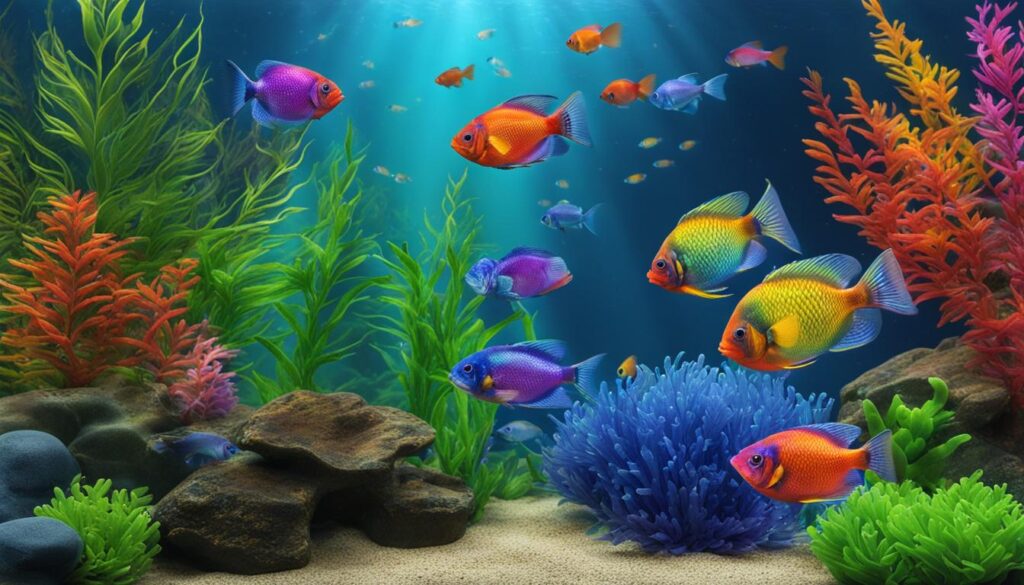
To maintain a thriving rainbow fish community, several factors should be considered. We want our rainbow fish community to be healthy, happy, and active.
Suitable Tank Conditions
First and foremost, we need to ensure that the tank conditions are suitable for our rainbow fish. They require a well-maintained and cycled aquarium with stable water parameters. Keeping the tank clean is an important aspect of maintaining a healthy environment for your rainbow fish. Regular water changes and gravel cleaning should be done to remove any accumulated waste or debris.
The ideal temperature range for rainbow fish is between 75°F and 81°F, with a pH level between 7 and 8. You may also want to add live plants to your tank as a natural source of food, oxygen, and shelter for your rainbow fish.
Adequate Space
Adequate space is crucial for maintaining a thriving rainbow fish community. Rainbow fish require ample swimming space, and overcrowding can lead to stress and aggressive behavior. A general guideline is to provide at least one gallon of water per inch of adult fish.
Proper Nutrition
Proper nutrition is essential for the health and vitality of your rainbow fish. A balanced diet should include a variety of high-quality flakes, pellets, frozen or live foods such as brine shrimp, bloodworms, and daphnia. Overfeeding can lead to poor water quality and health problems, so be sure to feed your fish only what they can consume in a few minutes.
Preventing Diseases and Parasites
Preventing diseases and parasites is an essential aspect of maintaining a thriving rainbow fish community. To avoid introducing illnesses to your tank, quarantine new fish for at least two weeks before adding them to the community. Always wash your hands thoroughly before and after handling fish or performing maintenance tasks on the tank. Regularly monitor your rainbow fish for any signs of illness, such as lethargy, loss of appetite, or abnormal behavior.
Following these guidelines can help you maintain a thriving rainbow fish community. We want our fish to be healthy, happy, and active, and creating a suitable environment for them is the first step.
Guidelines for Keeping Rainbow Fish Together
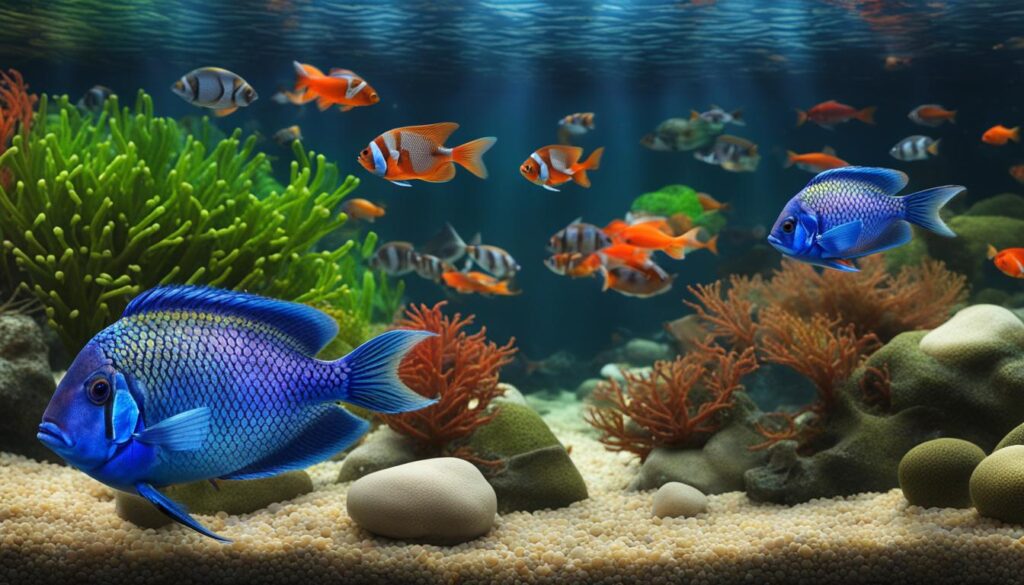
If you’re considering creating a rainbow fish community, there are a few guidelines you should follow to ensure their well-being. Rainbow fish are known to be peaceful, but they can become aggressive towards their own kind if they feel overcrowded or stressed. Here are some considerations for keeping rainbow fish together:
Tank size
The first consideration when keeping rainbow fish together is the size of your tank. Rainbow fish are active swimmers, and they need ample space to swim around. As a general rule, plan for at least 20 gallons of water for every three to four adult rainbow fish. If you plan on keeping more than four rainbow fish, you’ll need to add an additional 10 gallons of water for each fish.
Water parameters
Rainbow fish prefer slightly acidic water with a pH range of 6.5 to 7.5. They also require good water flow and filtration to keep their environment clean and healthy. To ensure the optimal water parameters for your rainbow fish, you’ll need to monitor the water chemistry regularly and perform water changes as needed.
Male-to-female ratio
A balanced male-to-female ratio is crucial for a healthy population of rainbow fish. A good rule of thumb is to maintain a ratio of one male to two or three females. This will help to minimize aggressive behavior among males and also ensure that reproductive success is maximized.
Suitable tankmates
When selecting tankmates for your rainbow fish, it’s essential to choose species that share similar temperaments and requirements. Avoid keeping aggressive species or fish that are much smaller than the rainbow fish, as they may become targets for aggression. Suitable tankmates for rainbow fish include other peaceful community fish such as neon tetras, guppies, and corydoras catfish.
Feeding
Rainbow fish are omnivores, and they require a varied diet to maintain optimal health. Offer a mix of high-quality flake food, frozen or live food such as brine shrimp or bloodworms, and fresh vegetables like spinach or lettuce.
Following these guidelines for keeping rainbow fish together will help ensure a happy and healthy community. Remember to monitor their behavior regularly and make adjustments as needed to provide the best possible care for your rainbow fish.
Optimal Number of Rainbow Fish in a Tank
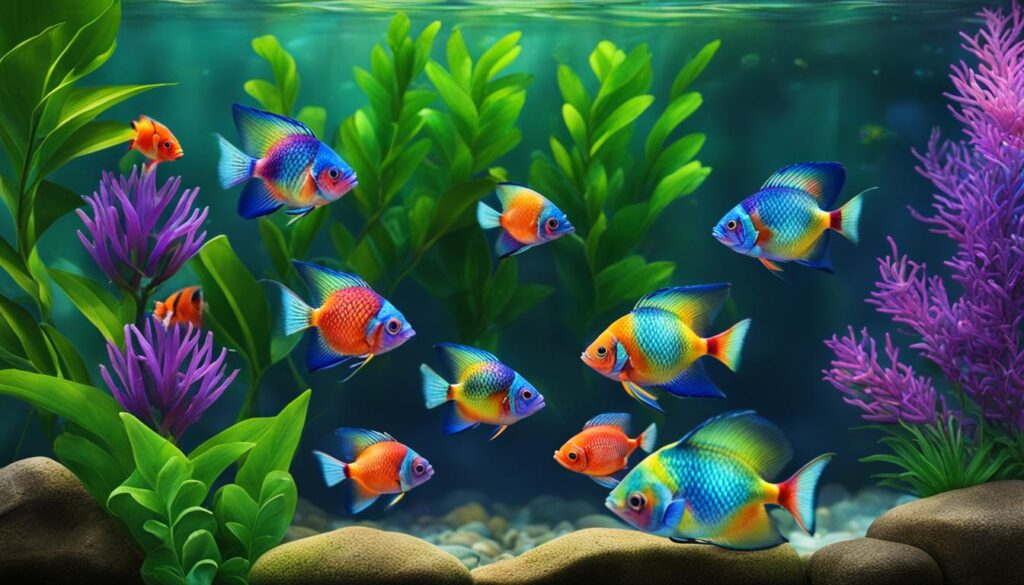
When deciding how many rainbow fish to keep in a tank, it is essential to consider several factors. The optimal number depends on the tank’s size, filtration capacity, and the specific needs of the fish species.
Rainbow fish are known to be active swimmers, so providing enough swimming space is crucial for their well-being. A good rule of thumb is to allocate at least 20 gallons of water for the first fish and an additional 10 gallons for each additional fish.
Additionally, the filtration system should be able to handle the waste produced by the fish, ensuring that the water quality remains pristine. A suitable filter should be able to process the tank’s water volume three to five times per hour.
| Number of Rainbow Fish | Tank Size | Filtration Capacity |
|---|---|---|
| 2-4 | 20-40 gallons | 120-200 gallons per hour |
| 5-8 | 50-80 gallons | 300-400 gallons per hour |
| 9-12 | 100-120 gallons | 600-1000 gallons per hour |
As shown in the table above, the optimal number of rainbow fish to keep in a tank increases with the tank size and filtration capacity. However, keep in mind that overstocking the tank can lead to stress, aggression, and poor water quality, which can have detrimental effects on your fish’s health.
It is also essential to consider the male-to-female ratio of the rainbow fish population. A balanced ratio of one male to two or three females can help minimize aggression and promote breeding success.
Ultimately, maintaining a healthy and thriving rainbow fish community requires careful consideration of multiple factors, including tank size, filtration capacity, and population management. By following these guidelines, you can create a beautiful and harmonious aquatic environment that your rainbow fish will thrive in.
Suitable Tankmate Recommendations for Rainbow Fish
Rainbow fish are a peaceful species that can coexist with other aquatic creatures that share their temperament and water requirements. Choosing suitable tankmates is essential for creating a harmonious aquatic environment for your rainbow fish. Here are some recommendations for compatible tankmates to consider:
| Species | Ideal Number | Water Conditions |
|---|---|---|
| Dwarf Gourami | 1-2 per tank | pH 6.0-7.5 |
| Corydoras Catfish | 3-4 per tank | pH 6.5-7.5 |
| Bristlenose Pleco | 1-2 per tank | pH 6.5-7.5 |
| Neon Tetra | 5-6 per tank | pH 6.0-7.0 |
| Harlequin Rasbora | 5-6 per tank | pH 6.0-7.0 |
It’s important to note that some fish may not be suitable tankmates for rainbow fish due to their aggressive behavior or incompatible water conditions. Avoid keeping fin-nipping species or those that require vastly different pH levels.
By carefully selecting compatible tankmates, you can create a thriving and diverse aquatic community that your rainbow fish will enjoy.
Suitable Rainbow Fish Tank Population: Maintaining a Healthy and Balanced Community
Ensuring a suitable rainbow fish tank population is vital to maintain a healthy and harmonious aquatic environment. Overcrowding can lead to stress, aggressive behavior, and poor water quality, while too few fish can result in boredom and social isolation. To determine the ideal number of rainbow fish in an aquarium, several factors need to be considered.
Tank Size and Filtration Capacity
The size of the tank is a crucial factor in determining the suitable rainbow fish tank population. A larger tank can accommodate more fish, providing them with enough space to swim and thrive. A general rule of thumb is to allocate at least 2 to 3 gallons of water per adult rainbow fish. If you have a 30-gallon tank, you can keep up to 10 to 15 adult rainbow fish. However, this may vary depending on the filtration capacity and the presence of other aquatic species in the tank.
Male-to-Female Ratio
Maintaining a balanced male-to-female ratio is essential to avoid aggression and promote breeding. A suitable male-to-female ratio for rainbow fish is 1:2 or 1:3, meaning one male for every two or three females. This ratio ensures that there is sufficient competition for mating while reducing aggression between males.
Population Management
Regular monitoring of the rainbow fish population is critical to ensure that the tank is not overcrowded. As the fish grow and mature, their social behavior may change, and the population dynamics may shift. It is vital to keep a close eye on their behavior and adjust the population accordingly.
Safe Number of Rainbow Fish to House Together
If you’re considering keeping rainbow fish in your aquarium, one of the essential things to keep in mind is the safe number of fish to house together. Overcrowding can lead to stress, aggression, and poor water quality, which can affect the health and well-being of your fish. So, how many rainbow fish can you safely keep in your tank?
The answer to this question depends on various factors, such as the size of your tank, the filtration capacity, and the specific needs of your rainbow fish species. Generally, a good rule of thumb is to allocate at least one gallon of water per inch of adult fish. For rainbow fish, the recommended tank size is at least 20 gallons.
Male-to-Female Ratio
Another aspect to consider when determining the safe number of rainbow fish to house together is the male-to-female ratio. Ideally, you should have more females than males since males can be territorial and aggressive towards each other. A suitable male-to-female ratio is one male to two or three females, depending on the species.
Compatible Tankmates
When selecting tankmates for your rainbow fish, it’s essential to choose species that share similar water requirements and temperament. Some suitable tankmates for rainbow fish include other peaceful community fish such as corydoras catfish, neon tetras, and guppies. Avoid aggressive or larger species that can prey on your rainbow fish.
Table: Safe Number of Rainbow Fish to House Together
| Tank Size (Gallons) | Number of Rainbow Fish | Male-to-Female Ratio |
|---|---|---|
| 20 | 5-6 | 1:2-3 |
| 30 | 8-10 | 1:3-4 |
| 50 | 12-15 | 1:4-5 |
This table shows a general guideline for the safe number of rainbow fish to house together based on tank size and male-to-female ratio. However, keep in mind that these are merely recommendations, and you should always consider the specific needs of your rainbow fish species and the capacity of your tank’s filtration system.
By following these guidelines and monitoring the overall well-being of your rainbow fish, you can maintain a healthy and thriving aquatic community in your home aquarium.
Rainbow Fish Groups and Schooling Behavior
If you’re considering keeping rainbow fish, it’s essential to understand their schooling behavior. Rainbow fish are known for their social and playful nature, and they thrive in groups with their own kind.
Keeping rainbow fish in groups of at least six individuals is recommended, as this allows them to establish a hierarchy and reduces aggression. A group of six also increases the chances of breeding and maintaining a healthy population.
It’s fascinating to watch rainbow fish interact with each other in a group. They form tight-knit schools, swimming together in unison, and displaying their vibrant colors. Rainbow fish are naturally curious and love to explore their surroundings, and keeping them in groups enhances their natural behavior.
Providing plenty of hiding places and plants in the aquarium creates a more comfortable environment for the fish and encourages them to form schools. The addition of driftwood or rocks also adds visual interest to the aquarium while providing a place for the fish to rest or hide.
“Rainbow fish are social creatures that thrive in groups. Keeping them in a school allows them to establish a hierarchy and reduces aggression while enhancing their natural behavior.”
It’s worth noting that while rainbow fish are social, they can also be aggressive towards each other, especially when establishing a hierarchy. Providing a large enough tank with plenty of swimming space and hiding places can help reduce aggression. It’s essential to observe the fish’s behavior and separate any overly-aggressive individuals to prevent injury and stress to the other fish.
In summary, keeping rainbow fish in groups enhances their natural behavior and allows them to establish a hierarchy while reducing aggression. Providing plenty of plants, hiding places, and swimming space creates a comfortable environment for the fish to thrive. Remember to observe their behavior and provide adequate space to reduce aggression and maintain a harmonious community.
Maintaining a Harmonious Rainbow Fish Community
Keeping a thriving rainbow fish community requires attention to the social behavior of the fish, suitable tankmates, and population management. By implementing the following techniques, you can promote a peaceful and healthy environment for your rainbow fish.
Provide Adequate Space
Rainbow fish need enough space to swim freely without feeling cramped. Overcrowding causes stress, aggression, and can lead to poor water quality. As a general rule, provide at least 20 gallons of water per adult rainbow fish.
Choose Suitable Tankmates
Rainbow fish can coexist peacefully with certain species that share similar water requirements and temperament. Avoid placing aggressive fish or those significantly smaller or larger than rainbow fish in the same tank. Suitable tankmates for rainbow fish include small tetras, guppies, and rasboras.
Monitor Water Parameters
Maintaining proper water conditions is crucial for the well-being of rainbow fish. Regularly monitor water temperature, pH, ammonia, nitrite, and nitrate levels. Perform partial water changes every two weeks or as necessary to keep the water clean and healthy.
Feed a Balanced Diet
Providing rainbow fish with a balanced and varied diet is essential to maintain their health and vitality. Offer a mix of flake, pellet, and frozen foods, including live or frozen brine shrimp, bloodworms, and daphnia. Depending on their age and size, feed rainbow fish once or twice a day.
Manage Aggression
Rainbow fish can display territorial behavior, especially during breeding. Providing plenty of hiding spots and visual barriers can help alleviate aggression. If aggression persists, consider separating the aggressive fish or adding more plants and decorations to break up line-of-sight.
Check Male-to-Female Ratio
Maintaining an appropriate male-to-female ratio is important to prevent aggression and breeding competition. For every male rainbow fish, provide at least two female rainbow fish. Avoid keeping more than one male in the same tank unless you have a large aquarium with adequate hiding spots to minimize aggression.
Observe Reproductive Behavior
If you plan to breed rainbow fish, observe their reproductive behavior carefully and provide the appropriate environment and conditions. Separate the breeding pair from the main tank to prevent other fish from eating the fry.
Stay Vigilant
Regular observation of your rainbow fish is vital to noticing any signs of illness or abnormal behavior. If you notice anything unusual, address the issue promptly through water changes, medication, or consulting with a veterinarian or aquatic specialist if necessary.
By following these guidelines for maintaining a thriving rainbow fish community, you can enjoy a beautiful and peaceful aquarium. Remember to provide adequate space, choose suitable tankmates, monitor water parameters, feed a balanced diet, manage aggression, check male-to-female ratio, observe reproductive behavior and stay vigilant to ensure the optimal well-being of your rainbow fish.
Conclusion
In conclusion, if you’re wondering how many rainbow fish should be kept together, there are a few factors to consider. First, it’s important to understand the social behavior of rainbow fish, including their schooling habits and territorial nature. It’s also important to maintain a balanced male-to-female ratio and provide adequate space, suitable tank conditions, and proper nutrition for your fish.
Determining the optimal number of rainbow fish to keep in your tank depends on various factors, such as tank size, filtration capacity, and the specific needs of the fish species. It’s important to avoid overcrowding to prevent stress, aggressive behavior, and other issues that can harm the well-being of your fish.
To maintain a thriving and harmonious rainbow fish community, it’s important to provide suitable tankmates that can complement the rainbow fish community and promote peaceful coexistence. You should also monitor the overall well-being and reproductive success of your fish and manage aggression if needed.
By considering these factors, you can ensure the optimal well-being of your rainbow fish community. So if you’re looking to add some color and life to your aquarium, follow these guidelines to keep your rainbow fish happy and healthy!
FAQ
How many rainbow fish should be kept together?
The optimal number of rainbow fish to keep together depends on tank size and filtration capacity. As a general guideline, you should aim for a minimum of three to four rainbow fish to create a harmonious social dynamic. However, larger tanks allow for larger schools of rainbow fish, and a group of six to eight can be a great starting point.
What are some suitable tankmate recommendations for rainbow fish?
Rainbow fish can coexist peacefully with species that share similar water requirements and temperament. Some suitable tankmates include guppies, tetras, mollies, and corydoras catfish. It is important to avoid aggressive or fin-nipping species to maintain a peaceful community.
How do rainbow fish behave socially?
Rainbow fish are social creatures that exhibit schooling behavior. They establish a hierarchical structure within their group and thrive in larger numbers. Rainbow fish also have a territorial nature, so providing ample swimming space and suitable hiding spots is essential for their well-being.
What guidelines should I follow when keeping rainbow fish together?
When keeping rainbow fish together, it is crucial to provide a tank size that allows for sufficient swimming space and reduces territorial disputes. Maintaining stable water parameters, such as temperature and pH, is important. Additionally, having a balanced male-to-female ratio is recommended to minimize aggression.
What is the optimal number of rainbow fish to house in a tank?
The optimal number of rainbow fish to house in a tank depends on factors such as tank size, filtration capacity, and the specific needs of the fish species. As a general rule, a starting population of six to eight rainbow fish is ideal for a medium-sized aquarium, but larger tanks can accommodate larger populations.
How can I maintain a healthy rainbow fish population?
Maintaining a healthy rainbow fish population involves providing suitable breeding conditions, managing aggression through proper tank setup, and maintaining a balanced male-to-female ratio. Regular monitoring of water quality, feeding a nutritious diet, and creating a stress-free environment are also important for their overall well-being.
What is the safe number of rainbow fish to house together?
To ensure the well-being of rainbow fish and maintain a healthy environment, it is important to avoid overcrowding. As a general guideline, aim for one gallon of water per inch of adult fish. This will help prevent stress-related issues, aggressive behavior, and potential water quality problems.
Do rainbow fish need to be kept in groups?
Yes, rainbow fish are naturally schooling fish and thrive when kept in groups. Grouping them together mimics their natural behavior and provides social interaction, which is important for their overall well-being. Keeping rainbow fish in groups also reduces stress and helps prevent aggressive behavior.
How can I maintain a harmonious rainbow fish community?
To maintain a harmonious rainbow fish community, it is important to provide suitable tankmates, ample swimming space, and hiding spots. Monitor the social dynamics within the group and intervene if any aggression or hierarchy issues arise. Regular water parameter checks and proper nutrition are also vital for their overall health.
What is the key to creating a thriving rainbow fish community?
Creating a thriving rainbow fish community requires providing adequate space, maintaining stable water conditions, and offering a balanced diet. It is essential to research the specific needs of rainbow fish and their potential tankmates to ensure compatibility. Regular observation and addressing any behavioral issues promptly will help maintain a thriving community.

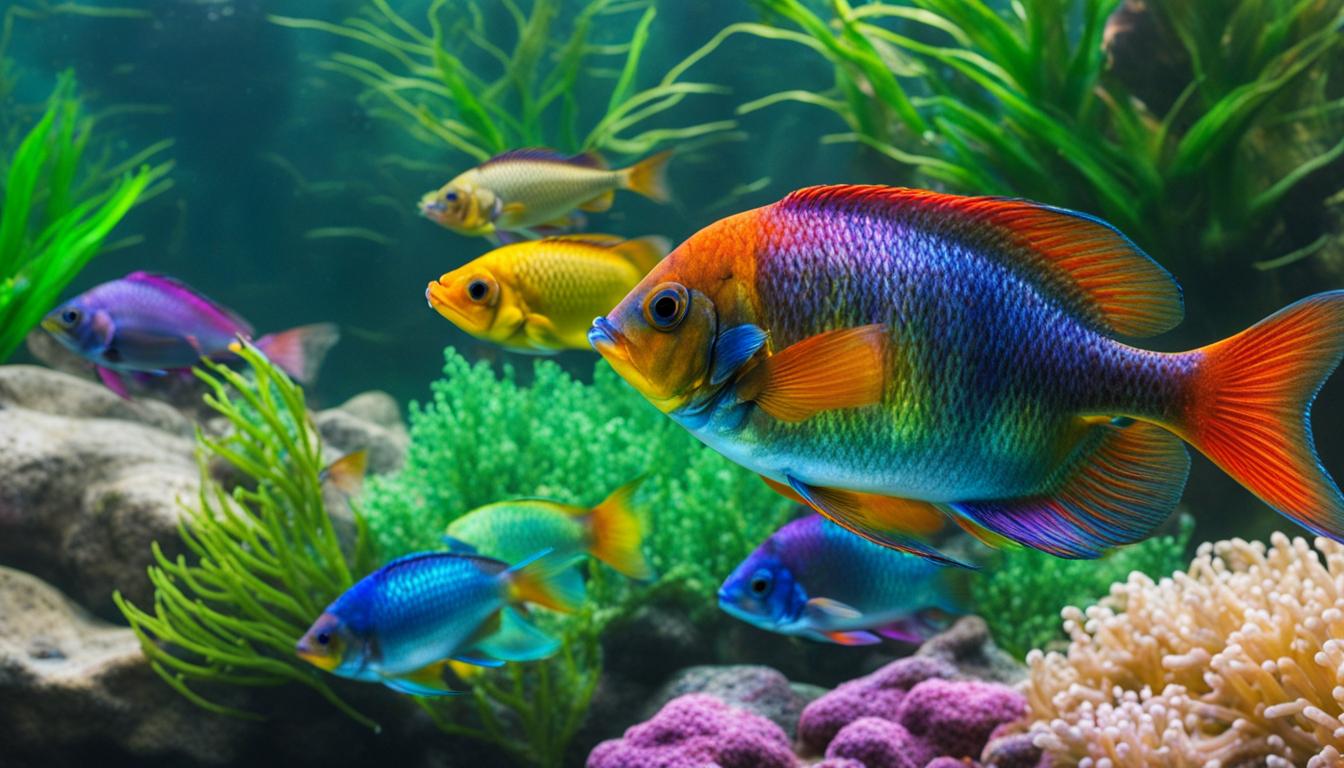


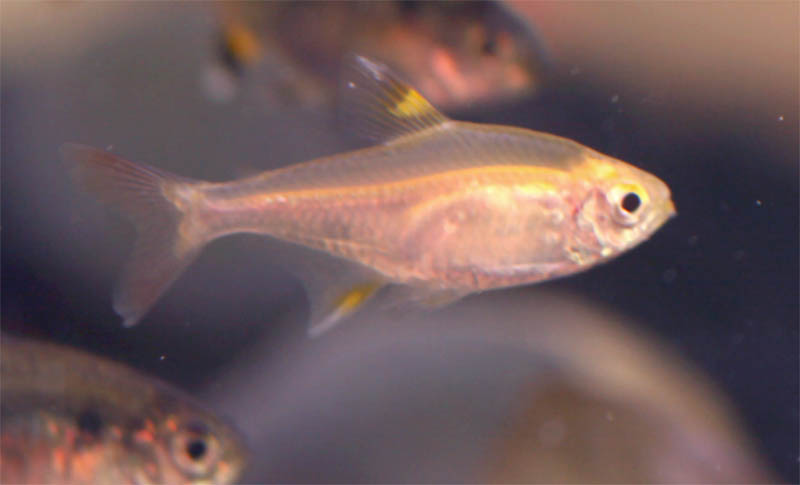
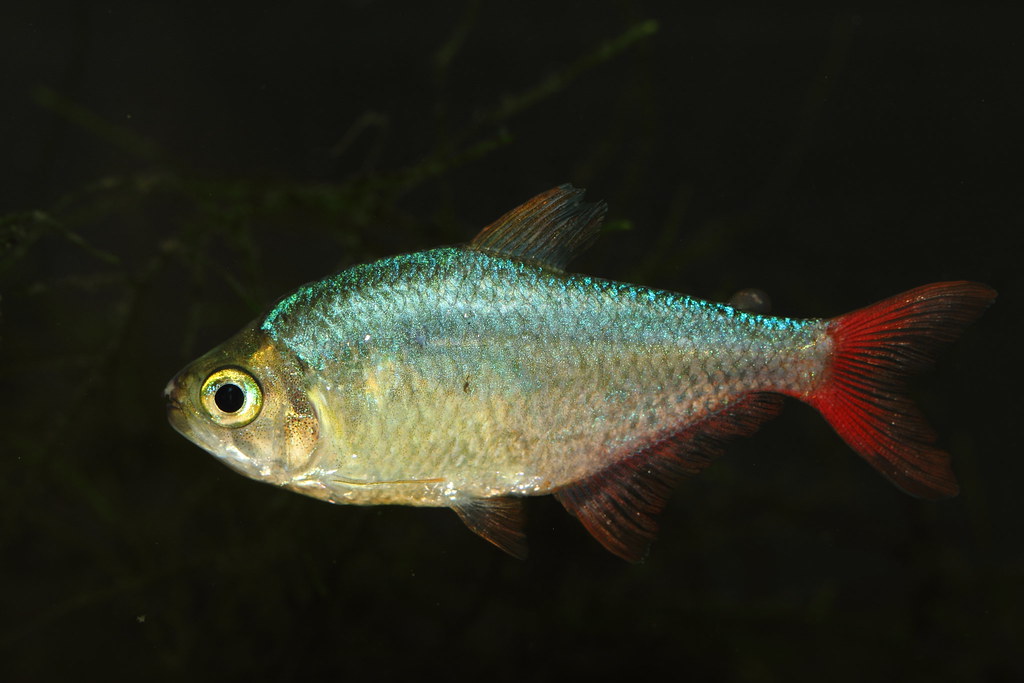
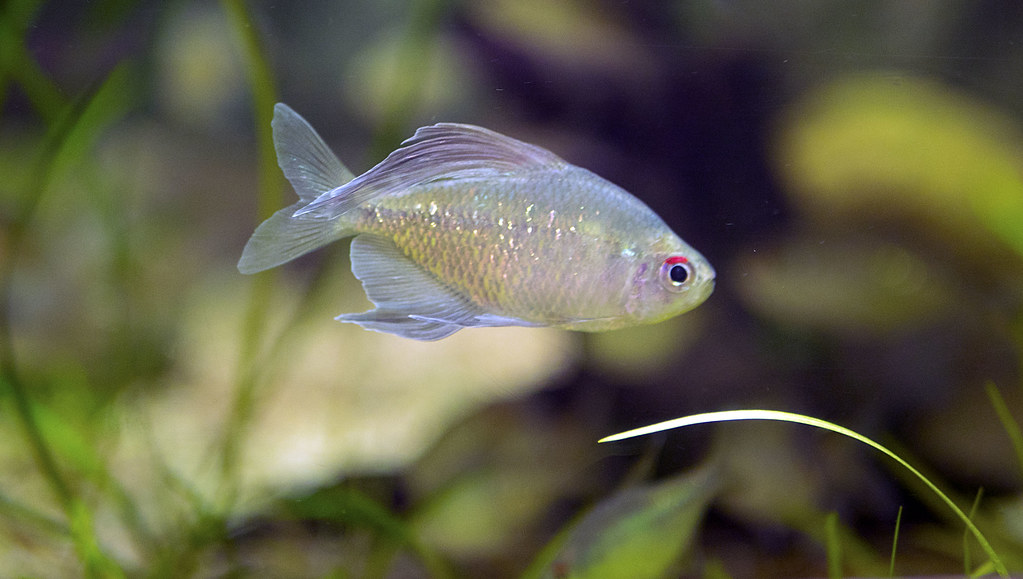
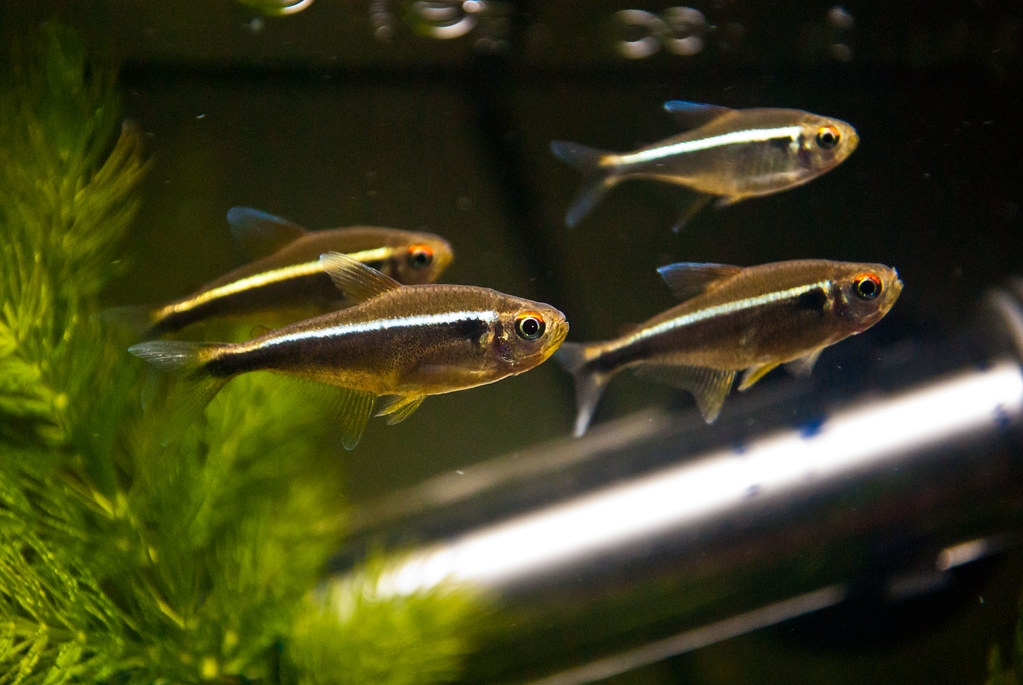
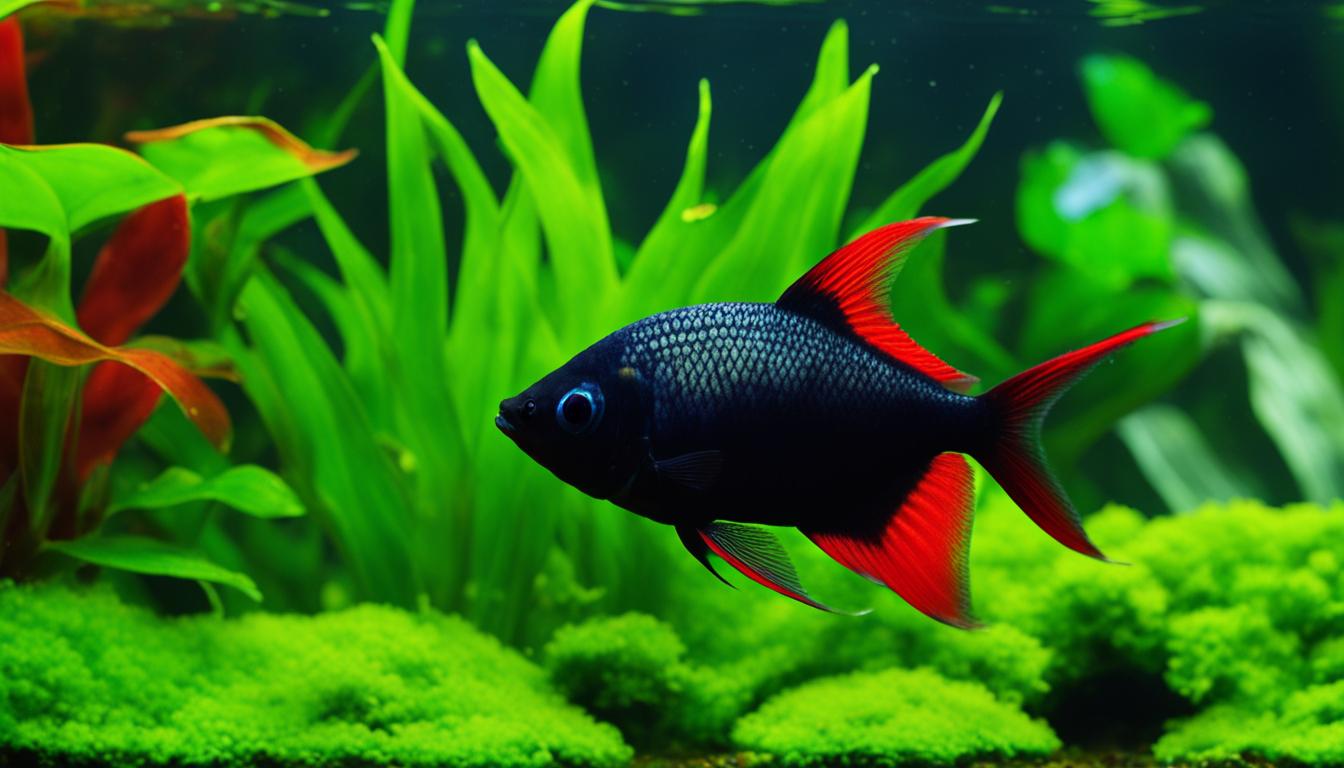
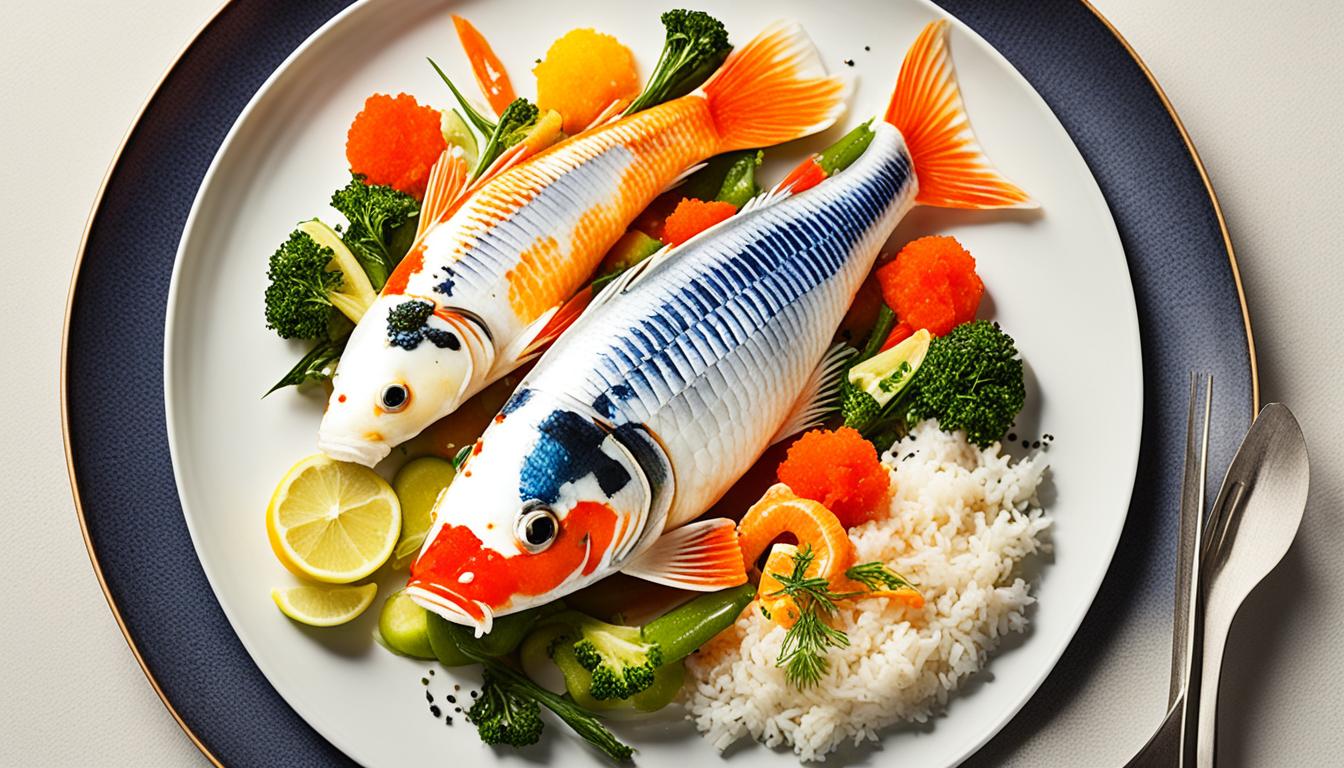
[…] allure of guppy fish, also known as million fish or rainbow fish, is strong in the aquarium community. They come in a myriad of vibrant colors and tail shapes, […]